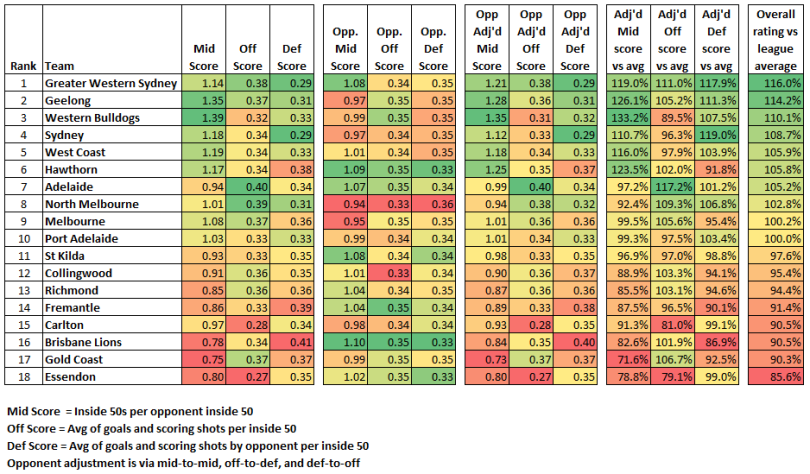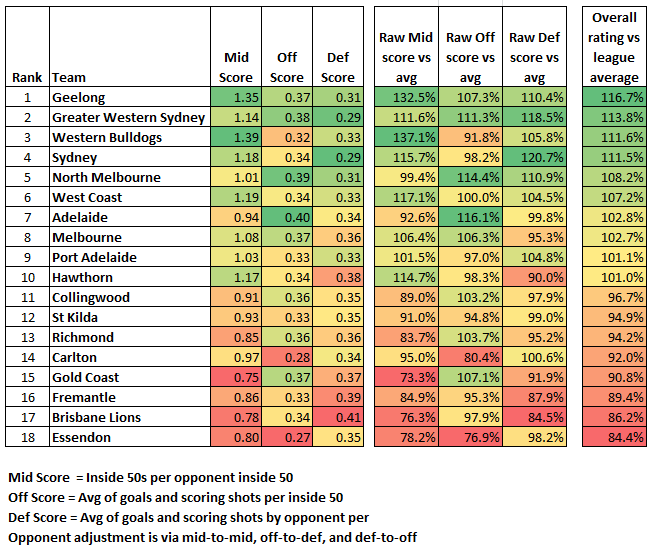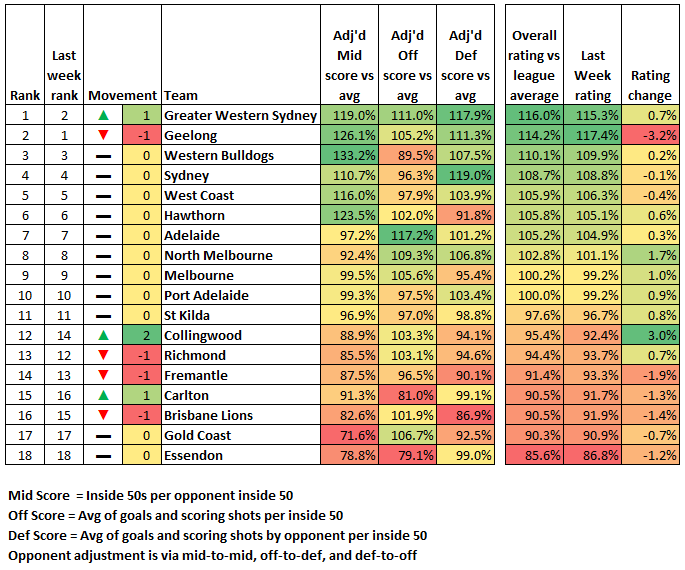The pundits are, for the moment, right about North Melbourne. For a side sitting two games clear on top of the ladder, they don’t present as an overwhelmingly strong side, and their weak schedule must be factored in when looking at where they sit.
This year we’ve been rating teams after each round in terms of three strength measures defined based on inside-50s. Midfield strength by the balance of inside-50s gained and conceded, forward strength by scoring efficiency, and defence strength on opponent scoring inefficiency.
Perceptive readers will note that in the table below, we rate the undefeated North Melbourne’s performance on as the eighth best in the league once adjusted for their opponents to date:

The bright red bar lighting up North’s opponents’ scores highlights the key feature of North Melbourne’s schedule – a soft opening half. In fact, North have beaten only two sides currently in the top eight (Adelaide and the Bulldogs), and no other side in the top 4. They’ve beaten no side higher than 15th on the ladder, or 16th in our ratings, at either one of their home grounds.
This suggests a much tougher draw yet to come.
They’ve done what they needed – win all 9 games – but these figures suggest they haven’t been dominating those teams by as much as would be expected of a top side. To get an idea of how much North Melbourne’s down-scaling has impacted them, here’s the raw ratings without opponent adjustment:

North Melbourne now rate above West Coast, Adelaide and Hawthorn. The Hawks, in particular, look much worse without considering their opponent set (as do Brisbane and, to an extent, Fremantle). Sydney and the Bulldogs are modestly downscaled having also had slightly easy draws, but they retain their third and fourth place rankings.
On raw scores we can see that without considering opponent, North have basically broken even in the midfield this year, have had a forward line nearly as dominant as Adelaide’s, as well as a reasonably strong defence. With scaling, the North midfield moves down to 92% of league average and forward and defensive measures also scale well down. In short: North have been only good against (mostly) very bad teams.
And the upshot is that yes, North are undefeated, but that they’ll need to improve to maintain their ladder position going forward. If they continue to do well, these ratings will rise as their draw gets more difficult. If they start struggling, it will be a reflection of the lower underlying strength that we think we’ve identified here.
They are, however, on the way up after a strong performance this weekend, the biggest ratings riser amongst teams that aren’t Collingwood:

Notable here is also that Sydney dropped slightly and Hawthorn rose. We turned out to be correct in our guess at how the game would go based on our ratings:
Sydney looks much stronger in defence but a little weaker in the midfield and forward. Hawthorn we assume are starting to build like they usually do, and Sydney have had two bad performances in a row. The ratings suggest a game where the Swans concede a few more inside 50s but contain Hawthorn to a lower score by virtue of defending them much better.
Specifically, Sydney lost the inside-50s but then defended them extremely well. The shots they gave up were mostly poor quality ones, illustrating the degree to which Sydney’s defense won the game:

As a result, Sydney’s defensive rating rose but the other two measures fell, and the opposite happened for Hawthorn. Hawthorn appears to have a significant issue in their defence, which any number of armchair commentators predicted with the departure of Brian Lake. But as it sits, we suggest that the Hawks brains’ trust would also kill for Kyle Chaney back as well.
Premiership windows
We’ve noted that these measures correlate pretty well with success, and two weeks ago we looked at where teams this year are sitting in relation to the past on our 3-measure strength ratings.
Only two premiers since 1998 have finished below league average (100%) on any one of the three measures – Sydney’s forward line in 2005 at 98.9% and North’s midfield at 96.6% in 1999. The lowest aggregate rating for a premier was those same two sides; Sydney 105.0% and North 105.9%.
On the basis of these minimums, currently the teams tracking for premiership contention are GWS and Geelong, who are both clearly above average in all three measures and the strongest looking teams overall.
Five other teams have overall scores in this +105% range – Bulldogs, Sydney, West Coast, Hawthorn and (barely) Adelaide. However if we also consider individual component scores, the Bulldogs have serious questions over a very low offensive efficiency and Hawthorn over their defensive efficiency. No team has made a grand final with an individual component score that low in any category.
Sydney and West Coast’s forward strength and Adelaide’s midfield strength are around the 97-98% mark of those past two “weak” premiers with below-average ratings components, suggesting an uphill battle for them as well.
North Melbourne, meanwhile, come into consideration only on the basis of their raw scores, not their adjusted scores, at this point. As we discussed earlier, their movements over a few more games will tell the tale.
In short, despite Geelong’s stumble against the Pies, right now sit with GWS as the most well-rounded of the contenders in the season to date.
